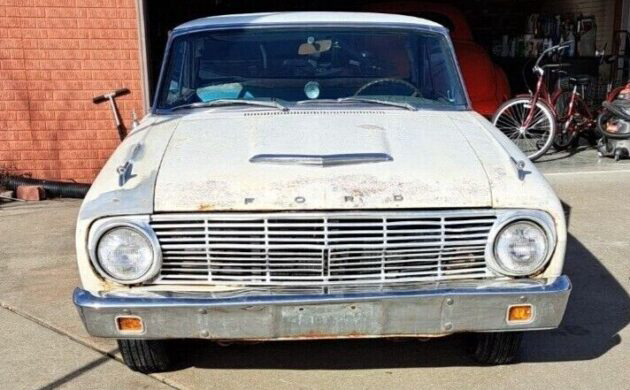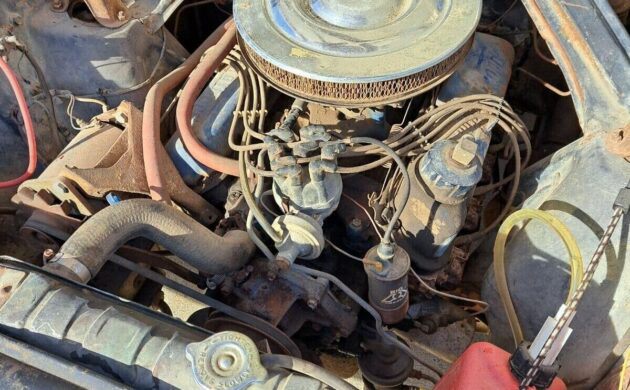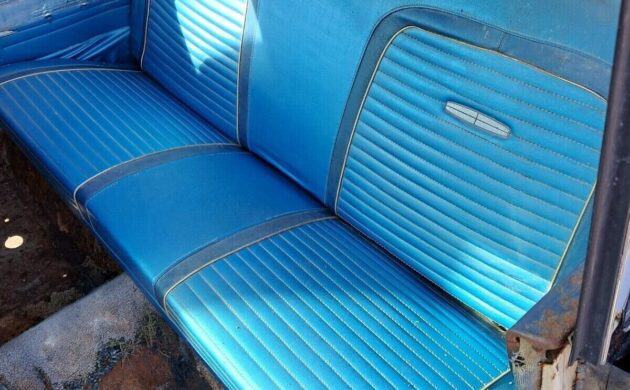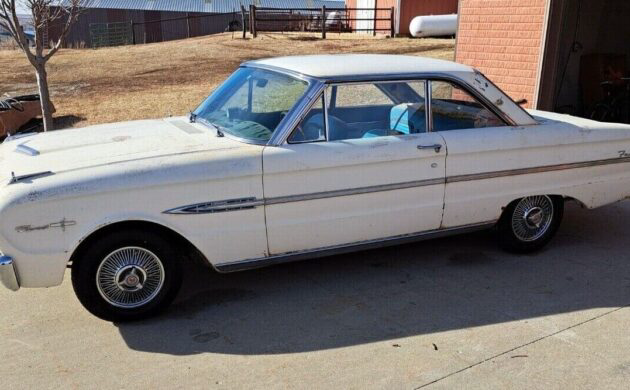Ford introduced the Sprint version to its Falcon Futura range in 1963, slotting the 260ci “Challenger” V8 under the hood to unlock additional performance. Buyers could order their new Sprint with 1-of-3 transmissions, the most desirable being the four-speed manual. The original owner of this car selected that combination, and after sixty years in their care, it needs to head to a new home and an owner willing to recapture its lost youth. The Sprint is listed here on eBay in Carson, Iowa. Bidding has passed the reserve to sit at $3,450.
The seller listed this Corinthian White Futura Sprint on behalf of the original owner and acknowledges that it could serve as either a project or a parts car. Its recent history is unclear, but it may not have seen active duty for a while. It requires total restoration, and that process will include significant rust repairs. It has sunk its talons into the rear quarter panels, lower front fenders, floor pans, and front inner wheel wells. The quarter panels will require replacement, and I had no trouble finding a supplier producing replacements for under $800 per pair. More intense searching may unearth companies that could undercut that figure. The remaining rust issues may respond positively to well-crafted patches, which could be the most cost-effective approach when considering this Sprint’s potential value. There are no significant dents or bruises, and the glass looks okay. The new owner may need to open their wallet further because a few trim pieces are beyond salvation.
Lifting the hood reveals what set the 1963½ Sprint apart from its siblings. The most potent version of the ’63 Futura Hardtop featured a 170ci six delivering 101hp. It produced a ¼-mile ET of 19.2 seconds when coupled with a four-speed manual transmission. The Sprint brought the first V8 to the Falcon range in the form of the 260ci “Challenger.” With 164hp under the right foot and a four-speed handling the shifting duties, that figure dropped to 17.1 seconds. It is worth noting that the following year’s Mustang Hardtop with the same configuration produced similar numbers, making the Sprint a sleeper. The seller states that although the car isn’t roadworthy, it runs and drives. Stopping is another matter because it has no brakes! The owner recently fitted a new battery and tires, which gives the buyer a point from which to work. If an in-person inspection confirms there is no structural rust, returning the Futura to a roadworthy state could be an achievable short-term goal.
The interior photos are not great, but they make it clear that this classic requires a complete interior restoration. Most upholstered surfaces are beyond salvation, and a trim kit would be the most logical and cost-effective solution. Unfortunately, kits for Futuras are more expensive than for First Generation Mustangs, with the new owner needing to budget at least $2,500 to achieve a showroom-fresh appearance. That isn’t chickenfeed and may determine the new owner’s future plans for this classic.
The 1963½ Falcon Futura Sprint was a significant car for Ford because its mechanical configuration served as an entree for what potential buyers could expect from the First Generation Mustang that appeared a year later. It was the first time the company offered a V8 in its Falcon range, and while it sold 266,526 Falcons across all derivatives in that year, only 10,479 buyers selected the Sprint Hardtop. The Mustang decimated the sales of what should have been a showroom success and massively impacted secondhand values. Many of these classics ended their lives in scrapyards, and those that remain command significantly lower prices than an equivalent ‘Stang. Even restored to a high standard, this Sprint would struggle to achieve a price beyond $25,000 in the current market. The one ray of light in that scenario is that values are climbing in double-digit territory. Even if the purchase and restoration costs push beyond that magic figure, a buyer could potentially recoup that through long-term ownership. That makes it a project worth a closer look.







I know projects are going for more than I think they should but this should be a 3500 dollar car, sorry. Been mudded and painted at least once. Shock towers are rough, passenger side behind the tower is rough. Floors may end with a few spots and no idea what the drivetrain condition is in. I really like these cars but this is a real project car. Shame it wasn’t cared for a little better. But it was just an old Falcon and driven. I know someone will pay more but I don’t get it, going to take some time and bucks to make this one nice.
I think these are pretty cool when restored. It’s a humble Falcon, but with a sporty roofline and nice trim and a V8, they turned into a desirable car. It’s too bad this one is rough. Like Cadmanls says, it would be a big (read: expensive) project.
This is my favorite Falcon body style, and they only made it for 1 year. There were no hardtops before ’63 and in ’64 they changed the body style. If you can do the work yourself it may be worth it. These are hard to find.
whats the one yr-ness of it? The gun sights were on several yrs, same cheveron on hood? may B the spears on the sides?
I like the ’round body (’60/3) as a lill less angular’n less chrome than the ‘square body’, ’63/5. The ’65/70 moved back to rounded a bit. Now the one yr I know of was ’70 1/2 – almost looks like a nova (3rd gen) it’s so rounded.
The 63, with the “semi” fastback roof design was a ONE YEAR ONLY body style. And the 70 1/2 Falcon looked nothing like a Nova, it was a stripped down Torino, only made for half a model year.
60-63 , 64-65 , 66 -70 , 70 1/2 Those are the basic body styles. The 63 Futura hardtop had a completely different roof line than the first gen bodies. .
Well, there’s no such thing as a cheap restoration, whether it’s a Falcon or something else. Judging by the valve covers, the motor is either a late 289, or a 302, or somebody replaced the valve covers once upon a time. I’ve always loved these Sprints, if I had the room for another project I’d be all over it.
Well if the winning bidder follows through my guess is they will use it for parts there is a lot more rust under that paint I would have the body mount bolts checked before driving it
Late ‘63 1/2 Falcons were in fact available with the 289 V8. I knew someone in the late ‘60s who bought one new. Metallic blue/blue bucket seat interior, 289/3 speed. Emblazoned with “Sprint” and “289” emblems. I also remember Ford running an ad in Hot Rod (Or another car magazine) with a picture of a ‘63 1/2 Falcon, with the headline reading “Throw Away Your Boring Bar!” going on to explain that Falcons were now available with the 289. I too have read that 260s were the biggest engine available- but I was there. Read the ad/saw the car.
NEVER had a 289, no such thing in 63. the first 64 1/2 mustang had a 260.
I love Falcon Sprints. This one is pretty rough with rust and body issues, but the V8 and 4speed spice things up abit. Quarter panel replacements will be like surgery and cost $2500 for welding labor work unless buyer can tackle himself. That plus the cost of Quarter panels. Did it on a Mustang and swore never again. Possible to maybe do patch welds if it’s not so bad but if it’s into the wheel wells and rockers, that’s a no go.
Used to paper the dorm room with exhibition of speed and speeding tickets from my Sprint.
’69 I climbed into a friends brandy new 1 w/the 302 (289 avail the same yr too (and 1 more yr of choice?). Nice fresh smelling show room car, last I remember B4 seein just the telephone wires (wheel stand). He could wrench! Light body (down sized car), truck motor. Even tho new he had gone all over it (new brakes, suspension) top flight interior. WoW, he loved that car~
No 289 in 69, it was replaced by the 302 in midyear 68.
Unless the 302 was really REALLY built and the Falcon severely modified, no new Falcon would be doing wheelies . And a truck 302 was basically the same as the car 302 . just your basic entry level v8
A driver’s door mirror would be a wise addition.
Has a modern rear view mirror attached to windshield – might as well retain it, espec if it’s a day-nite one.
Interesting it has proper hood springs!
Mom’s ’60 comet did not, & i remember the hood being heavy as hell to raise, & i hated the prop rod. I guess the ’59-60(at least) falcon also used a prop rod. Surprised ANY falcon or comet got hood springs, since the later ’70s Maverick/Comet did not ever have em.
I wonder if there was ever a kit to convert a prop rod hood to 1 with proper springs.